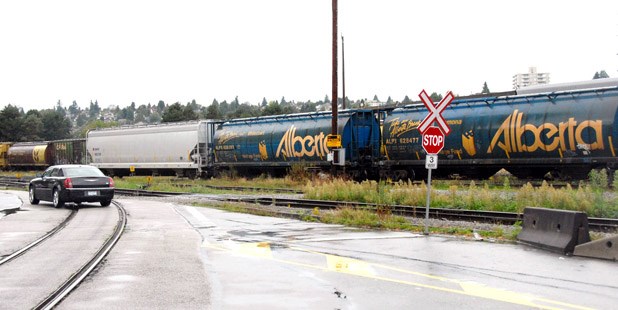The City of New Westminster is hoping to strike up a hazardous materials team to address the potential for “catastrophic” incidents in the city.
Firefighters in Alberta responded on the weekend after train cars carrying oil and gas derailed, creating a situation that was so volatile that they backed off and let the fire burn out. It’s the latest in a series of rail incidents that has prompted New Westminster Fire Chief Tim Armstrong to recommend that the city consider the formation of a hazardous materials team for New Westminster.
Armstrong’s report – Quayside Drive: Transportation of Dangerous Goods – states that New Westminster doesn’t have the capability to respond to a large incident and needs assistance from outside municipalities or agencies.
According to the report, fire department staff are currently trained to an operations level, where they are able to recognize potential hazardous materials incidents, isolate and deny entry to other responders and the public, evacuate people in danger and take defensive actions such as shutting off valves and protection drains – without having any contact with the product.
“For New Westminster to have its own hazardous material team in the city would provide protection for its residents, businesses and visitors, as our municipality in recent years has grown to be a transportation hub,” Armstrong stated in the report.
Coun. Chuck Puchmayr believes it’s timely for the city to begin looking at creating its own response to hazardous materials. He said it would require some additional training, but would allow the city to take action immediately, rather than waiting for people from other municipalities or agencies.
“As far as emergency response or haz-mat, it would be the same anywhere in the city,” he said about hazardous materials.
A staff report noted that a number of rail incidents have occurred lately, which has heightened the need to do a comprehensive review of the city’s emergency procedures and the transportation of dangerous goods in New Westminster. As part of its 2014 budget, the fire department will put forward a budget submission that includes an increased capability to respond to hazardous material spills or releases in the city.
Armstrong told council that rail transport is probably one of the safest means of moving dangerous goods, but if an accident happened it could be catastrophic.
Puchmayr said the Quayside area probably poses one of the more challenging issues with evacuation, especially if there are flames or hazardous materials on the rail lines.
According to Armstrong’s report, the 2011 census indicated about 7,085 people live in the Quayside area, which doesn’t reflect people who are visiting or working in the area each day.
The fire department is currently creating a plan for the Quayside area that would be used if a hazardous material incident occurred. The plan would include a list of substance that pass through the Quayside area and the type of emergency response needed for each product.
“Looking forward into the fall of 2013, New Westminster Fire and Rescue Services and the Emergency Management Office is evaluating the current options for river evacuation points along the Quayside waterfront,” stated the Oct. 7 report. “This type of evacuation would only occur in the event that access has been severed to the Quayside area and evacuation of the area is needed.”
Currently, people are able to access the Quayside neighbourhood via Begbie Street and the Third Avenue and McInnes Street overpasses.
Ammonia, carbon dioxide, chlorine, hydrogen peroxide, methanol, propane, sodium borohydride, sulphur dioxide and sulphuric acid are among the dangerous goods transported by rail.
The report also points out that dangerous goods are also transported by truck throughout Metro Vancouver, including New Westminster. The fire department was unable to find any statistics about the types of hazardous materials and products being transported by road through New Westminster.
The City of New Westminster has established a community advisory panel with the four railways operating in the city to discuss a variety of issues including safety and whistle cessation. The Greater Vancouver Fire Chiefs Association has also established a sub-committee to gather information about the transportation of dangerous goods.



